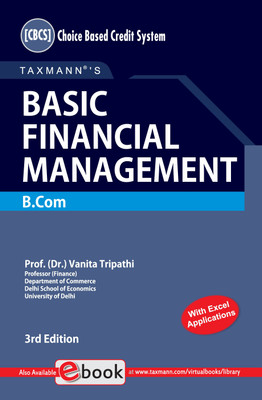Taxmann's Basic Financial Management ŌĆō Comprehensive, Authentic & Illustrated Textbook featuring elementary understanding of concepts, plus financial decision making through Excel | CBCS(Paperback, Prof. (Dr.) Vanita Tripathi)
Quick Overview
Product Price Comparison
Basic Financial Management is a comprehensive, authentic & well-illustrated book. This book aims to fulfil the requirement of students of undergraduate courses in commerce and management, particularly the B.Com. under the CBCS Programme, Non-Collegiate Women's Education Board (NCWEB), and School of Open Learning (University of Delhi). This book will also be applicable for undergraduate commerce & management courses at various Central Universities throughout India. The Present Publication is the 3rd Edition, authored by Prof. (Dr.) Vanita Tripathi, with the following noteworthy features: (1) [Elementary but Comprehensive Understanding of Concepts] and techniques related to financial management and financial decision making (2) [Examples & Illustrations] have been incorporated throughout this book to make the understanding of the concepts easy (3) [Student-Oriented Book] This book has been developed, keeping in mind the following factors: (a) Interaction of the author/teacher with their students in the classroom (b) Shaped by the author/teachers experience of teaching the subject-matter at different levels for about 17+ years (c) Reaction and responses of students have also been incorporated at different places in the book (4) [Solved Previous Exam Question Papers] are covered at the end of the book for the last few years. This will help the students to have a clear idea of the questions usually asked (5) The structure of this book is as follows: (a) [Learning Outcomes] Every chapter begins with a list of learning outcomes that the reader will achieve after completing the chapter. It sets the broad framework for the chapter (b) [Main Text] Various concepts and techniques have been explained in a lucid and well-knit manner. Wherever required, the explanation is supplemented by suitable illustrations and examples (c) [170+ Solved Problems] Each chapter provides a sufficient number of solved problems for better understanding and application of the concepts explained in the main text (d) [Summary] Each chapter provides a sufficient number of solved problems for better understanding and application of the concepts explained in the main text (e) [Test Yourself] Each chapter provides sufficient number of solved problems for better understanding and application of the concepts explained in the main text (f) [Excel Applications in Financial Management] The book also contains excel applications in financial management in relevant chapters using a spreadsheet (1) The contents of the book are as follows: (a) [Financial Management & Time Value of Money] The first unit deals with the overview of financial management and the concept of time value of money. It comprises of two chapters: (I) Chapter 1 explains the evolution, nature, scope and objectives of financial management (II) Chapter 2 explains the concept and techniques of time value of money (b) [Capital Budgeting] The second unit provides a detailed discussion on capital budgeting and the cost of capital. It comprises of three chapters: (I) Chapter 3 explains the importance of capital budgeting decisions and estimation of cash flows, (II) Chapter 4 discusses elementary techniques of evaluating capital projects, and (III) Chapter 5 presents the concept and calculation of the cost of capital (c) [Financial Leverage & Capital Structure] The third unit comprehensively explains leverage analysis and financing decisions in a firm, popularly known as capital structure decision. It has two chapters: (I) Chapter 6 presents the concept and calculation of various types of leverages, and (II) Chapter 7 provides theories of capital structure and factors affecting capital structure choice in an organisation (d) [Dividend Decision] The fourth unit comprehensively discusses dividend decisions. Theories of dividend and dividend policies form the core part of this chapter. Students are also explained the importance of a stable dividend policy and various factors affecting dividend decisions in an organisation (e) [Working Capital Management] The last unit deals with working capital management, which spans over four chapters: (I) Chapter 9 provides an overview of working capital and explains estimation of the net working capital requirement in a firm, and (II) Chapters 10, 11 and 12 explain cash management, receivables management and Inventory management, respectively

